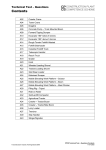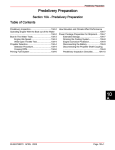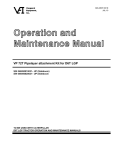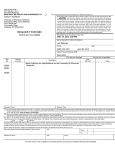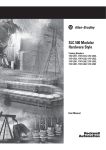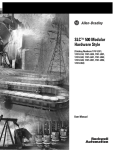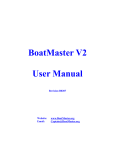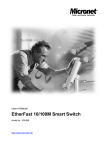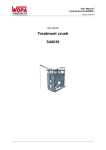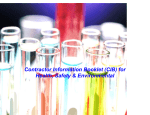Download Machine Specification and User Manual
Transcript
Machine Specification and User Manual 16-30" Pipe Bending Machine S/N: 399 Table of Contents I Introduction Orientation Major Components Pin-up Shoe Clamps Stiffback Tongue Pipe Rollers Controls Stiffback Control Valve Pin-up Control Valve Winch Control Valve Pressure Control II Operation Pre-Starting Checks Starting Pipe Loading Mandrel to Die Reference Bending Reference Pull interval index Pipe leveling reference Pipe bending reference Production Operation Shut Down Procedure Bending and Operating Problems III 4 4 5 5 6 6 6-7 7 7-8 8 8-9 Maintenance Lubrication Engine Bushings Hydraulic Tank Pin-up Wedge Pipe Size Change Over IV 1 1 1 1-2 2 2 2 2 2 2 2 3 10 10 10 10 10 10 Safety Safety summary 11-12 I. Introduction This machine was designed and built to bend sixteen through thirty inch pipe. It should not be use to straighten crooked or bent pipe. It should not be used to bend pipe that is bent or crooked. Orientation The enclosed drawing of the 16-30 PBM has encircled part numbers, each of which refers to a machine part or detail. Refer these identifying numbers from this manual and the enclosed parts list. The operating controls and operators platform are on the side from which the machine is operated. With the operator standing on the platform facing the machine, the front of the machine or stiffback end of the machine is to the left, the rear of the machine, or pinup shoe end is to the right. Major components The Hydraulic power system consists of a Vickers hydraulic pump directly driven by a CAT diesel engine. This hydraulic pump supplies the hydraulic power for all the cylinders and for the hydraulic winch motor. The Pinup Shoe This is the fabricated shoe in the rear of the machine which supports the pipe while bending. The shoe rest on a base which slides on the wedge when the pinup cylinder is actuated. Clamps The clamps are hinged to the top of the pinup and are powered by the clamp 1 cylinder that is connected to the stiffback hydraulic circuit. When the stiffback is in use the clamps close. When the stiffback is lowered the clamps open. The clamps keep pipe from getting out-of-round while bending. Stiffback The stiffback is an integral part of the machine. It is actuated by four cylinders, two outboards, and two inboards. The inboard cylinders are actuated first by the hydraulic systme to force the pipe into the die. When the pressure increases and movement of the cylinders decreases, the outboard cylinders are automatically moved up to furnish the leverage required to bend the pipe. Tongue The tongue is attached to the front bottom side of the stiffback. It is used in conjunction with the tractor draw bar to move the machine from one location to the other. Pipe Rollers The front roller is attached to the tongue, the rear roller is attached to the frame between the stiffback and the pinup. When the rollers are properly positioned and the stiffback are down the pipe rest on the rollers and not on the stiffback - thus permitting easy movement of the pipe through the machine. The Controls Stiffback Control Valve This valve is to the operators rights. Pushing the valve lever forward moves the stiffback into the up position. Pulling the valve handle back return the stiffback into the down position. Pinup Control Valve Pushing the valve handle forward moves the pinup shoe up. Pulling the handle back moves the pinup back to the down position Winch Control Valve Pushing the valve handle forward will cause the winch to wind. Pulling the valve handle back will cause the winch to unwind. 2 Pressure Control The Hydraulic relief valve controls the maximum hydraulic pressure in the system. The pressure can be adjusted to any pressure within the valve range. 3 II. Operation Pre-Starting Checks 1. Check oil in engine 2. Check water in engine 3. Check air cleaner 4. Check water in battery 5. Check fuel level in fuel tank 6. Check pipe roller setting. The top center of the rollers should be set slightly higher than the bottom curve of the stiffback liner when the stiffback is in the down position. 7. Check tension on the coil spring under the stiffback. The tension is adjusted by tightening or loosening the turnbuckle. 8. Check the oil level in the hydraulic tank. When all cylinders are in the down positions. Starting Follow engine manufacturers recommendation for starting and operating the engine. The instrument panel and throttle are located for easy access at operators position. After starting, allow hydraulic oil to circulate at moderate speed until it flows freely. When operating temperature has been reached, hydraulic system will operate more quietly than when cold Engine RPM should ne adjusted according to pipe wall thickness being bent. For heavy wall pipe, engine should be turning 2200 RPM. For thin wall pipe, engine should be turning at 2000 RPM. 4 Pipe Loading 1. Lower stiffback and pin-up to accept pipe. 2. Pipe is loaded through rear whenever mandrel is to be used; however, if mandrel is not to be used, load pipe through front of bender. 3. Sideboom should slightly raise the rear of the pipe so that the upper surface touches the die, and the lower front edge is on the stiffback. The purpose of this is to allow easy entry on the mandrel 4. Using manual controls, drive the mandrel into the pipe. 5. Sideboom should lower pipe to the level position and move it further inside the bending machine, but not beyond the front edge of the die. This is to ensure easy viewing of the mandrel when establishing its location under the die. Mandrel to Die Reference The mandrel must be accurately positioned beneath the die and remain in the same position during each bend. If the mandrel is not properly positioned pipe wall buckling or other damage will occur. Since the mandrel is not clearly visible during operation an external reference must be used to locate mandrel. This can be done by stacking the end of the bending machine and stacking the end of the mandrel reach rod and aligning the reach rod with the stack marker during each bend. Sideboom may have to release pipe at rear and move around to the front of the machine to support the pipe as it is being winched through. Otherwise, pipe will be unbalanced and tilt. 5 Bending References After mandrel positing references have been established, three other references must be established and marked: (1) Index for pull interval marks, (2) Pipe leveling references, and (3) Pipe bending references. The first reference mark is used to align intervals marked on pipe. The second mark is used as a starting point to begin measuring the amount of bend. The third mark represents the number of degrees/bend. Leveling and bending references are marked on a calibrated rod on the front of the machine. Pull interval index During the bending process, pipe is moved at predetermined interval with the bender. Intervals are marked, with chalk or a grease pencil, along the side of the pipe for easy viewing by the operator. To move the pipe at equal distances a mark should be made on the stiffback line so the reference marks on the pipe can be aligned with it. Pipe leveling reference The amount which pipe is bent during each pull. Mark is determined between two reference marks, leveling reference and bend reference. Both references are to be established and marked on a rod that extends upward from the outboard cylinder operator side. Proceed as follows. Note: It is assumed that pipe has been moved through the machine until the tail end of the pipe with the rear of the bending machine. There is an unbendable area at each end of the pipe. Egging may occur if bending is attempted in these areas. 1. Level pipe in bending machine A. Move stiffback valve forward carefully until stiffback raises pipe against die slightly 6 B. Move Pin-up valve forward, causing pin-up shoe to move up against the pipe. C. Measure distance from lower front edge of die to top of pipe between rear lower edge of die and top of pipe. Compare the measurements. First dimension should be 1/4" less than measurement taken at rear of die. This is to cause pipe to start bending from the middle of the die forward. If front dimension is greater, lower pin-up shoe slightly, snug stiffback up, and re-measure. Repeat until level position is obtained,. When pipe level, mark calibrated rod where is emerges through the guide tube. Pipe Bending References Bending references can be established as follows: 1. Raise pipe to level position. The stiffback valve lever is moved forward until lever reference mark on rod moves slightly above opening in guide tube. Release to hold stiffback in position. Pin-up liver is moved forward until pin-up moves firmly against pipe the released to hold pin-up position. 2. When pipe is level, begin bending in small increments until desired amount of bend is obtained. Production operation With bending references established, begin production bending process. 1. Have helper pull winch cable out to end of pipe so it can be advanced by the winch. 2. With stiffback and pin-up down, use mandrel valve to move pipe until number two interval mark aligns with index mark on stiffback. 3. Reposition mandrel under die. 4. Expand mandrel 7 5. Level pipe using stiffback and pin-up and leveling mark as a reference. 6. Bend pipe using stiffback valve and bending mark as a reference. 7. Lower stiffback, pin-up and mandrel and verify pipe is bent correctly. 8. After pipe has been bent satisfactorily, remove it through rear of machine similar to the method used in loading it. Before pipe is completely removed raise outer most end slightly so that mandrel operator may remove the mandrel. 9. Repeat steps 1-8 for remaining pipe joints. Shut down procedure Return pin-up and stiffback to the down position and turn engine off. Bending and Operating Problems Common bending problems and remedies. 1. Pipe egging is caused by excessive compression at one place. Lengthen bend out of possible and check to make sure pipe is being bent in front half of die. 2. Buckling of pipe may be caused by excessive bending or an improper procedure. If a proper procedure has been followed and a buckle develops, double check procedure. Other causes of buckling are (1) wave in pipe wall, (2) dented pipe, (3) inconsistent wall thickness, and (4) variation of hardness of pipe. 3. If die is marking side of pipe in bending, then die is improperly lined up with stiffback and pin-up. 4. If pipe being bent shown excessive scratching check the following: 1. Leading edges of pin-up, stiffback and die for sharp edges. 2. Variation in hardness of pipe. 3. Tractor holding straight with machine while bending 4. Wave in pipe wall. 5. Pin up wedges slipping-remove excess oil and roughen surface of wedges. 8 6. Rollers that are set too high will be damaged in bending or will damage pipe. Rollers that are set too low are useless and make moving pipe through machine difficult. 7. Packing glands that are leaking oil should be tightened down evenly. If leakage is not stopped remove seal retainer and place shim between it and packing, then re-tighten. 8. If stiffback is raised too high pistons in the cylinder may pass bypass port and stick there. With engine shut off, a weight such as a tractor boom laid on the tongue will cylinder back to operating position. 9 III. Maintenance Lubrication Engine. Check crankcase oil and level daily. Change oil and filter as described in manual. Bushings. Use grease gun on roller shafts and other fittings daily. Hydraulic Tank. Check hydraulic fluid level in tank daily. Condition of hydraulic return line filter should be checked daily. Pin-up Wedge. Oil top of wedge sparingly. Too much oil may cause wedge to slip during bending Pipe size change-over To change from 30 inch pipe to a smaller size, a new die, stiffback liner (two pieces), pipe clamp liner (two pieces) and pin-up liner must be installed this is known as a bending set. 1. To gain access for other task remove die first, use hand winch above die to lower it and slide it out the stiffback end. 2. Install rear stiffback liner and secure it down with the hold downs located on the stiffback. 3. Installation of the front stiffback liner is the same as the rear. 4. Install pin-up liner and secure it with holds. 5. Install clamp liners and secure with bolts. 6. Install die of proper size. When the die is slid back under the die nest it is to be raised using the hand winch and then secured. 10 IV. Safety The following are general safety precautions and are instruction that people must understand and apply during the operation and maintenance of the equipment to ensure personal safety. User is responsible for providing safety equipment. Warning and Caution Statements Warning and caution statements have been placed throughout this text prior to operation or maintenance procedures. A warning and or caution will apply each time the related step is repeated. Prior to starting any task, the warnings or cautions included in the text will be reviewed and understood. Electrical circuits Operating personnel must think at all times. Do not replace or make adjustments inside equipment with the electrical power turned on. Under certain conditions, danger may exist with the power supply turned off due to charge capacitors. To avoid injury always remove the power, dry charge and ground circuit before touching. Always be sure all electrical equipment is properly grounded. Do not service alone Do not attempt service unless another person capable of rendering aid is present. Resuscitation Personnel working with or near dangerous voltage should be trained in methods of resuscitation. Cleaning/Chemical/Primers Some cleaners, chemical, paints, and primers have adverse effects on skin, eyes, and the respiratory tract. Observe warning labels. Compressed air Use of compressed air can create an environment of propelled particles. Do 11 not direct air stream towards self or any other person. Dangerous pressures Pressure systems apply to all ranges of pressure. Care must be taken during testing to ensure that all connection are proper and tight prior to applying pressure to test units. Lifting/handling Use only equipment rated above maximum load to be lifted. Use adequate number of personnel or appropriately rated lifting devices to move equipment. Hearing safety Prolonged exposure to loud noise can cause impairment or loss of hearing. Wear suitable hearing protective device to protect against loud noise. Batteries Keep sparks and flames away from batteries. Before you connect or disconnect a battery charger, turn off charge. Safety Equipment Wear safety equipment and fairly tight clothing when working with or near moving parts, hot parts, pressurized systems, electrical systems, or fuel systems. Safety warnings with Pipe Bending Machine Always work at ends of pipe, never between or in front of rolling pipe. Stay clear of pipe while rollers are operating. Do not operate travel car until personnel are clear of tracks. Only qualified personnel should attempt to operate or maintain equipment. Do not operate roller assemblies until all personnel are clear of pipe. Do not open chamber access doors until all chamber activity has ceased. Keep sparks and open flame away from dust collector. 12 PARTS ORDERING PROCEDURES 1. From the parts list in the manual state part number and description. 2. State quantity of each item you will be purchasing. 3. State your company name and address for invoicing. 4. State method of delivery you desire and address, if different than invoicing address. 5. State purchase order number. ORDER PARTS 24 HOURS A DAY SEVEN DAYS A WEEK. PHONE, FAX OR EMAIL. DMI INTERNATIONAL, INC. 15715 East Pine Street Tulsa, Oklahoma 74116 918-438-2213 Phone 918-234-9376 Fax [email protected] E-Mail PARTS ORDER FORM TO ORDER REPLACEMENT PARTS FOR YOUR DMI INTERNATIONAL, INC. EQUIPMENT PLEASE COMPLETE THE INFORMATION BELOW. 1. COMPANY NAME AND ADDRESS __________________________________________________________________ __________________________________________________________________ 2. PART NAME AND NUMBER __________________________________________________________________ __________________________________________________________________ 3. QUANTITY __________________________________________________________________ 4. EQUIPMENT SIZE AND MODEL NUMBER __________________________________________________________________ __________________________________________________________________ 5. TYPE OF DELIVERY __________________________________________________________________ IN ORDER TO SERVE OUR CUSTOMER WITH PROMPTNESS AND EFFICIENCY WE ASK THAT THE QUESTION ABOVE TO BE ANSWERED WHETHER ORDERING BY FAX OR CALL IN. DMI INTERNATIONAL, INC. 15715 EAST PINE STREET TULSA, OKLAHOMA 74116 918-438-2213 PHONE 918-234-9376 FAX




















